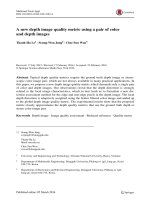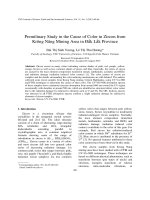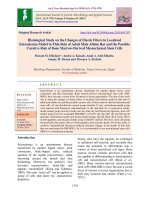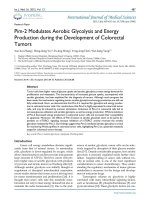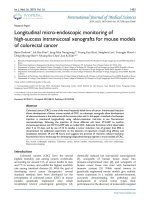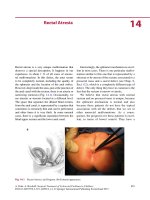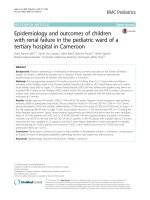Pediatric skin of color
Bạn đang xem bản rút gọn của tài liệu. Xem và tải ngay bản đầy đủ của tài liệu tại đây (20.15 MB, 451 trang )
Nanette B. Silverberg
Carola Durán-McKinster
Yong-Kwang Tay Editors
Pediatric Skin
of Color
123
Pediatric Skin of Color
wwwwwwwwwwwwww
Nanette B. Silverberg • Carola Durán-McKinster
Yong-Kwang Tay
Editors
Pediatric Skin of Color
Editors
Nanette B. Silverberg, M.D.
Department of Dermatology
Mt. Sinai St. Luke’s-Roosevelt Hospital
and Beth Israel Medical Centers
New York, NY, USA
Carola Durán-McKinster, M.D.
Department of Pediatric Dermatology
National Institute of Pediatrics
Mexico City, Mexico
Yong-Kwang Tay, F.R.C.P.
Department of Dermatology
Changi General Hospital
Singapore, Singapore
ISBN 978-1-4614-6653-6
ISBN 978-1-4614-6654-3 (eBook)
DOI 10.1007/978-1-4614-6654-3
Springer New York Heidelberg Dordrecht London
Library of Congress Control Number: 2015930251
© Springer Science+Business Media New York 2015
This work is subject to copyright. All rights are reserved by the Publisher, whether the whole or part of the material is
concerned, specifically the rights of translation, reprinting, reuse of illustrations, recitation, broadcasting, reproduction
on microfilms or in any other physical way, and transmission or information storage and retrieval, electronic adaptation,
computer software, or by similar or dissimilar methodology now known or hereafter developed. Exempted from this
legal reservation are brief excerpts in connection with reviews or scholarly analysis or material supplied specifically
for the purpose of being entered and executed on a computer system, for exclusive use by the purchaser of the work.
Duplication of this publication or parts thereof is permitted only under the provisions of the Copyright Law of the
Publisher’s location, in its current version, and permission for use must always be obtained from Springer. Permissions
for use may be obtained through RightsLink at the Copyright Clearance Center. Violations are liable to prosecution
under the respective Copyright Law.
The use of general descriptive names, registered names, trademarks, service marks, etc. in this publication does not
imply, even in the absence of a specific statement, that such names are exempt from the relevant protective laws and
regulations and therefore free for general use.
While the advice and information in this book are believed to be true and accurate at the date of publication, neither
the authors nor the editors nor the publisher can accept any legal responsibility for any errors or omissions that may
be made. The publisher makes no warranty, express or implied, with respect to the material contained herein.
Printed on acid-free paper
Springer is part of Springer Science+Business Media (www.springer.com)
This book is dedicated to my family: Wan Ching, Ern Wei, and Ern Ying
for their continuous love, support, patience, and understanding in allowing
me time to write and edit, and make everything worthwhile.
Yong-Kwang Tay, FRCP
This book is dedicated to the most important people in my life: my mentors,
Prof. Ramón Ruiz-Maldonado and Prof. Lourdes Tamayo, and my daughters,
Sofía and Natalia Deveaux-Durán. From all of them I have learned the
pleasure of teaching and sharing my experience and knowledge.
Carola Durán-McKinster, MD
This book is dedicated to my family and dearest colleagues who have made
this possible: my mentors who shared their skills with me and showed me a
path of educational exploration and on-going learning. But most importantly,
this book is dedicated to my parents and Harry for their unconditional love,
advice and support during the process and throughout my career.
Nanette B. Silverberg, MD
wwwwwwwwwwwwww
Preface
In the past, the majority of patients seen in the United States and Europe were fair-skinned
individuals; up to the 1970s and the early 1980s, most of the published studies in dermatology
were done in this population. With globalization of the economy and the advance of convenient
international travel, the proportion of people of color (POC) in North America and Europe are
rapidly increasing. Based on the latest (2010) US Census data, it has been estimated that by
July, 2013, 63% of the US population would be non-Hispanic whites, while the rest would be
POC, including Hispanic whites (1). The need for an increased understanding of skin conditions in POC is reflected by the formation of the Skin of Color Society by Susan Taylor, MD,
in 2004, the establishment of centers in several academic institutions focusing on POC, and the
publication of several general dermatology textbooks and atlases on this topic. This demographic shift is most notably seen in the number of skin of color-related sessions at the annual
meetings of the American Academy of Dermatology: in 1995, there were 3 sessions; in 2005, 5
sessions; and in 2015, 21 sessions.
Pediatric dermatology is an established subspecialty in dermatology. The 13th World
Congress of Pediatric Dermatology, currently being held every 4 years, is scheduled for 2017.
There are pediatric dermatology societies worldwide. In the United States, there are 31 pediatric
dermatology fellowship programs approved by the American Board of Dermatology (ABD),
leading to subspecialty certification of the graduates by the ABD.
Drs. Tay, Durán-McKinster and Silverberg are to be congratulated for editing this first textbook on skin of color in the pediatric patient population; they are eminently qualified to do so.
Dr. Tay practices in Changi General Hospital in Singapore, a city-state that is known for its
multicultural and multi-ethnic population. Dr. Durán-McKinster practices in Mexico City, a
city whose inhabitants have a wide range of skin phototypes. Dr. Silverberg practices in New
York City, and is affiliated with the first Skin of Color Center in the United States. They have
organized an international group of authors to cover all aspects of pediatric dermatology.
This textbook would certainly appeal to a worldwide readership of dermatologists, pediatric
dermatologists and pediatricians. It will be a frequently used reference in the daily practice of
all of us.
Chairman and C.S. Livingood Chair
Department of Dermatology
Henry Ford Hospital
Detroit, Michigan, USA
December 2014
Henry W. Lim, MD
vii
viii
References
1. Annual Estimates of the Resident Population by Sex, Single Year of Age, Race Alone or in Combination,
and Hispanic Origin for the United States: April 1, 2010 to July 1, 2013. Source: U.S. Census Bureau,
Population Division. Release Date: June 2014. http://factfinder.census.gov/ (accessed Dec. 29, 2014)
Perface
Contents
Part I
Biology of Normal Skin, Hair and Nails
1
Development and Biology of East Asian Skin, Hair, and Nails ............................
Mark Jean-Aan Koh
3
2
Developmental Biology of Black Skin, Hair, and Nails ........................................
Nikki Tang, Candrice Heath, and Nanette B. Silverberg
11
3
Pigmentary Development of East Asian Skin ........................................................
Kin Fon Leong
19
Part II
Pigmentary Conditions in Children of Color
4
Normal Color Variations in Children of Color .....................................................
Nanette B. Silverberg
63
5
Hypopigmenting Disorders .....................................................................................
Joni M. Mazza, Candrice Heath, and Nanette B. Silverberg
69
6
Mongolian Spots .......................................................................................................
Eulalia Baselga
89
7
Nevus of Ota and Nevus of Ito ................................................................................
Eulalia Baselga
93
8
Pigmentary Mosaicism ............................................................................................
Eulalia Baselga
97
9
Ashy Dermatosis or Erythema Dyschromicum Perstans ..................................... 101
Lynn Yuun Tirng Chiam
10
Confluent and Reticulate
Papillomatosis (of Gougerot–Carteaud Syndrome) .............................................. 105
Lynn Yunn Tirng Chiam
11
Idiopathic Eruptive Macular Pigmentation .......................................................... 109
Ramón Ruiz-Maldonado and Carola Durán-McKinster
12
Exogenous Ochronosis ............................................................................................. 113
Lynn Yuun Tirng Chiam
13
Metabolic Hyperpigmentation: Carotenemia, Pernicious Anemia,
Acromegaly, Addison’s Disease, Diabetes mellitus,
and Hemochromatosis ............................................................................................. 117
Luz Orozco-Covarrubias and Marimar Sáez-de-Ocariz
ix
x
Contents
Part III
Hair Diseases in Children of Color
14
Genetic Hair Disorders ............................................................................................ 127
Carola Durán-McKinster
15
Traction Alopecia ..................................................................................................... 137
Sejal K. Shah
16
Acne Keloidalis Nuchae ........................................................................................... 141
Mishal Reja and Nanette B. Silverberg
17
Pseudofolliculitis Barbae ......................................................................................... 147
Nanette B. Silverberg
Part IV Infections in Children of Color
18
Tinea Capitis in Children of Colour ....................................................................... 153
Catherine C. McCuaig
19
Cutaneous Infections ............................................................................................... 167
Patricia A. Treadwell
20
Molluscum Contagiosum, Viral Warts, and Tinea Versicolor ............................. 175
Yuin-Chew Chan
21
Skin Infections in Immunocompromised Children............................................... 185
Maria Teresa García-Romero
22
Tropical Infections ................................................................................................... 193
Héctor Cáceres-Ríos and Felipe Velásquez
Part V Neonatal Skin Diseases
23
Histiocytosis .............................................................................................................. 205
Blanca Del Pozzo-Magaña and Irene Lara-Corrales
24
Transient Neonatal Pustular Melanosis ................................................................. 223
Anais Aurora Badia, Sarah Ferrer, and Ana Margarita Duarte
25
Clear Cell Papulosis ................................................................................................. 229
Nanette B. Silverberg
26
Vascular Tumors/Birthmarks ................................................................................. 231
Francine Blei and Bernardo Gontijo
27
Congenital Melanocytic Nevi .................................................................................. 249
María del Carmen Boente
28
Becker’s Nevus ......................................................................................................... 261
María del Carmen Boente
Part VI
Inflammatory Skin Conditions and Dermatoses
29
Atopic Dermatitis in Pediatric Skin of Color ........................................................ 267
Aviva C. Berkowitz and Jonathan I. Silverberg
30
Contact Dermatitis ................................................................................................... 281
Rashmi Unwala and Sharon E. Jacob
Contents
xi
31
Seborrhoeic Dermatitis in Children ....................................................................... 289
Yee-Leng Teoh and Yong-Kwang Tay
32
Lichen Planus in Children....................................................................................... 295
Shan-Xian Lee and Yong-Kwang Tay
33
Pityriasis Rosea ........................................................................................................ 303
Shanna Shan-Yi Ng and Yong-Kwang Tay
34
Paediatric Psoriasis .................................................................................................. 309
Colin Kwok
35
Drug Eruptions......................................................................................................... 315
Patricia A. Treadwell
36
Infantile Acropustulosis ........................................................................................... 323
Nanette B. Silverberg
37
Pediatric Mastocytosis ............................................................................................. 327
Nisha Suyien Chandran
Part VII Acne and Acneiform Conditions
38
Pediatric and Adolescent Acne................................................................................ 341
Charlene Lam and Andrea L. Zaenglein
39
Periorificial Dermatitis ............................................................................................ 363
Adena E. Rosenblatt and Sarah L. Stein
Part VIII
Photosensitivity
40
Photosensitivity and Photoreactions in Pediatric Skin of Color .......................... 371
Meghan A. Feely and Vincent A. De Leo
41
Actinic Prurigo ......................................................................................................... 387
Sonia Toussaint-Caire
Part IX
Collagen Vascular and Inflammatory Skin Diseases
42
Collagen Vascular Disease: Cutaneous Lupus Erythematosus ............................ 399
Saez-de-Ocariz Marimar and Orozco-Covarrubias Luz
43
Autoinflammatory Syndromes................................................................................ 409
Antonio Torrelo and Lucero Noguera
44
Acute Hemorrhagic Edema..................................................................................... 415
Antonio Torrelo and Lucero Noguera
45
Henoch–Schönlein Purpura .................................................................................... 417
Antonio Torrelo and Lucero Noguera
46
Kawasaki Disease ..................................................................................................... 421
Lucero Noguera and Antonio Torrelo
Part X
47
Regional Ethnic/Racial Pediatric Dermatology
Traditional Chinese Medicine in Dermatology ..................................................... 427
Jean Ho and Poh Hong Ong
xii
Contents
48
Skin of Aboriginal Children .................................................................................... 439
John Su and Christopher Heyes
49
Skin Cancer Epidemic in American Hispanic and Latino Patients .................... 453
Bertha Baum and Ana Margarita Duarte
Index .................................................................................................................................. 461
Contributors
Anais Aurora Badia, D.O. Florida Skin Center, Fort Myers, FL, USA
Eulalia Baselga, M.D. Department of Dermatology, Hospital de la Santa Creu i Sant Pau,
Barcelona, Spain
Francine Blei, M.D. North Shore-Long Island Jewish Healthcare System, Lenox Hill,
Hospital/MEETH, Vascular Anomalies Program, New York, NY, USA
Bertha Baum, D.O. Larkin Community Hospital, FL, Mexico
Aviva C. Berkowitz, B.A. Department of Dermatology, Northwestern University, Chicago,
IL, USA
Vincent A. De Leo, M.D. Department of Dermatology, Mt. Sinai St. Luke’s-Roosevelt
Hospital Center and Mt. Sinai Beth Israel Medical Center, New York, NY, USA
María del Carmen Boente, M.D. Hospital del Niđo Jesús, Tucumán, Argentina
Héctor Cáceres-Ríos, M.D. Instituto de Salud del Niđo, Lima, Perú
Lynn Yuun Tirng Chiam, M.D. Mount Elizabeth Novena Hospital, Singapore
Yuin-Chew Chan, M.R.C.P. (UK) Gleneagles Medical Centre, Singapore, Singapore
Nisha Suyien Chandran, M.R.C.P. (UK) Division of Dermatology, University Medicine
Cluster, National University Hospital, Singapore
Ana Margarita Duarte, M.D. Miami Childrens Hospital/Children’s Skin Center, Miami, FL,
Mexico
Carola Durán-McKinster, M.D. Department of Pediatric Dermatology, National Institute of
Pediatrics, Mexico City, Mexico
Meghan A. Feely, M.D. Department of Dermatology Residency Program, PGY-2, Mt. Sinai
St. Luke’s-Roosevelt Hospital Center and Mt. Sinai Beth Israel Medical Center, New York,
NY, USA
Sarah Ferrer, D.O. West Palm Beach Hospital and West Palm Beach VA Medical Center,
West Palm Beach, FL
Bernardo Gontijo, M.D. Federal University of Minas Gerais, Belo Horizonte, MG, Brazil
Maria Teresa García-Romero, M.D., M.P.H. National Institute of Pediatrics, Department of
Dermatology, Insurgentes Sur 3700, México
Candrice Heath, M.D. Department of Dermatology, Mt. Sinai St. Luke’s-Roosevelt Hospital
Center, New York, NY, USA
Christopher Heyes, M.D. Department of Dermatology, Royal Melbourne Hospital, Parkville,
VIC, Australia
xiii
xiv
Jean Ho, M.R.C.P. (UK), M.Med. (Int Med) Mount Elizabeth Hospital, KK Women’s and
Children’s Hospital, Singapore
Sharon E. Jacob, M.D. Department of Dermatology, Lona Linda University, Faculty Medical
Offices, CA, USA
Mark Jean-Aan Koh, M.D. KK Women’s & Children’s Hospital, Singapore, Singapore
Colin Kwok, F.R.C.P. (Edin) Department of Dermatology, Changi General Hospital,
Singapore, Singapore.
Charlene Lam, M.D., M.P.H. Department of Dermatology, Penn State/Hershey Medical
Center, Hershey, PA, USA
Irene Lara-Corrales, M.D., M.Sc. Dermatology Section, Department of Pediatric Medicine,
The Hospital for Sick Children, University of Toronto, Toronto, ON, Canada
Shan-Xian Lee, M.R.C.P. (UK) Department of Dermatology, Changi General Hospital,
Singapore, Singapore
Kin Fon Leong, M.B.B.S. (UM), MRCPCH Kuala Lumpur General Hospital, Kuala
Lumpur, Malaysia
Joni M. Mazza, M.D. Department of Dermatology, Mt. Sinai St. Luke’s-Roosevelt Hospital
Center, New York, NY, USA
Catherine C. McCuaig, M.D. FRCP (C), DABD. Department of Dermatology, University
of Montreal, Quebec, Canada
Shanna Shan-Yi Ng, M.R.C.P. (UK) Department of Dermatology, Changi General Hospital,
Singapore, Singapore
Lucero Noguera, M.D. Hospital del Niño Jesús, Madrid, Spain
Poh Hong Ong, Ph.D. Nanyang Technological University, Singapore
Luz Orozco-Covarrubias, M.D. Department of Dermatology, National Institute of Pediatrics,
Insurgentes Sur 3700-C Col. Insurgentes-Cuicuilco, Mexico
Blanca Del Pozzo-Magaña, M.D. Dermatology Section, Department of Pediatric Medicine,
The Hospital for Sick Children, University of Toronto, Toronto, ON, Canada
Mishal Reja, B.A. Thomas Jefferson School of Medicine, Philadelphia, PA, USA
Adena E. Rosenblatt, M.D., Ph.D. Section of Dermotology, Department of Medicine,
University of Chicago, Chicago, USA
Ramón Ruiz-Maldonado, M.D. Department of Pediatric Dermatology, National Institute of
Pediatrics, Mexico City, Mexico
Marimar Sáez-de-Ocariz, M.D. Department of Dermatology, National Institute of Pediatrics,
Insurgentes Sur 3700-C, Col. Insurgentes-Cuicuilco, Mexico
Sejal K. Shah, M.D. Schweiger Dermatology, New York, NY, USA
Department of Dermatology, Mt. Sinai St. Luke’s-Roosevelt Hospital Center, New York, NY,
USA
Nanette B. Silverberg, M.D., FAAD, FAAP, Department of Dermatology, Mt. Sinai St.
Luke’s-Roosevelt Hospital and Beth Israel Medical Centers, New York, NY, USA
Department of Dermatology, Icahn School of Medicine at Mt. Sinai
Jonathan I. Silverberg, M.D., Ph.D., M.P.H. Department of Dermatology, Northwestern
University, Chicago, IL, USA
Contributors
Contributors
xv
Sarah L. Stein, M.D. Section of Dermotology, Departments of Medicine and Pediatrics,
University of Chicago, Chicago, USA
John Su, M.D. Monash university, Eastern Health Clinical School, VIC, Australia
Universty of Melbourne, Department of Paediatrics and Murdoch Children’s Research Insitute,
Royal Children’s Hospital, Parkville, VIC Australia
Nikki Tang, M.D. Department of Dermatology, Mt. Sinai St. Luke’s-Roosevelt Hospital
Center, New York, NY, USA
Yong-Kwang Tay, F.R.C.P. Department of Dermatology, Changi General Hospital,
Singapore, Singapore
Yee-Leng Teoh, M.R.C.P. (UK) Department of Dermatology, Changi General Hospital,
2 Simei Street 3, Singapore
Antonio Torrelo, M.D. Hospital del Niño Jesús, Madrid, Spain
Sonia Toussaint-Caire, M.D. Hospital General Dr. Manuel Gea González, México City,
México
Patricia A. Treadwell, M.D. Indiana University Health, Indianapolis, IN, USA
Rashmi Unwala, M.D. Mayo Clinic Arizona, Scottsdale, AZ, USA
Felipe Velásquez, M.D. Instituto de Salud del Niño, Lima, Perú
Andrea L. Zaenglein, M.D. Departments of Dermatology and Pediatrics, Penn State/Hershey
Medical Center, Hershey, PA, USA
Part I
Biology of Normal Skin, Hair and Nails
1
Development and Biology of East
Asian Skin, Hair, and Nails
Mark Jean-Aan Koh
Abstract
People of skin of color comprise the majority of the world’s population and Asian people
comprise more than half of the total population of the world. East Asia encompasses a subregion of Asia that may be defined in geographical or cultural terms. Geographically, it covers about 28 % of Asia and is populated by more than 1.5 billion people, just over one-fifth
of the world’s population. Countries traditionally classified as being part of East Asia include
China, Japan, North and South Korea, Mongolia, and Taiwan. Historically, many societies
in East Asia have been part of the Chinese cultural sphere. However, with the increasing
mobility of the world’s population over the past two centuries, people of East Asian descent
have fanned out to not only other parts of Asia but also to all other continents.
Keywords
Biology • East Asian Skin • Hair • Nails • Pigmentation • Melanosomes • Melanocytes
Development and Biology of Pigmentation
in East Asian Skin
• Melanocytes migrate as neural crest cells to the epidermis
where they reside within the basal epidermis and hair bulb
matrix.
• Difference in skin color is due to variations in number,
size, and aggregation of the melanosomes.
• Pigmentary skin disorders, e.g. post-inflammatory dyspigmentation, melasma, and lentigines, are commonly
seen in East Asians.
The hallmark biological feature of people of skin of
color is the amount and distribution of melanin in the skin.
Melanin is synthesised by melanocytes within melanosomes
[1, 2]. Melanocytes migrate as neural crest cells to the epidermis from the 18th week of gestation [3]. In the skin, the
melanocytes are resident within the basal epidermis and hair
M.J.-A. Koh, M.D. (*)
KK Women’s & Children’s Hospital, Singapore, Singapore
bulb matrix. Each melanocyte in the basal layer produces
dendrites that are associated with approximately 36 epidermal keratinocytes [4]. Tyrosinase, an enzyme critical to the
formation of melanin, is formed within the Golgi bodies of
melanocytes and transferred to melanosomes. Tyrosinase
converts tyrosine to dopa, which is then converted to dopaquinone. Dopaquinone is further oxidised to form eumelanin, which is brown-black in color. In contrast, pheomelanin
appears yellow-red and is formed by a shunt in the eumelanin pathway. Melanosomes are ultimately transferred to
keratinocytes either as aggregated, complex particles or discrete, single particles [5].
The difference in skin color between different races is due
to variations in number, size, and aggregation of the melanosomes found in melanocytes and keratinocytes [6]. The absolute number of melanocytes does not vary between races.
The melanosomes of East Asian subjects have been found to
be in aggregates but have a more compact configuration
compared to Caucasian skin, in which melanosomes are
more grouped. In contrast, the melanosomes in Black skin
are individually dispersed and not aggregated (see Tang N,
et al. Chapter 2; Developmental Biology of Black Skin, Hair,
and Nails) [7].
N.B. Silverberg et al. (eds.), Pediatric Skin of Color,
DOI 10.1007/978-1-4614-6654-3_1, © Springer Science+Business Media New York 2015
3
4
Sun exposure can also affect the grouping of melanosomes. Asian skin exposed to sunlight has been found to
have more non-aggregated melanosomes compared to nonexposed skin, which have more aggregated melanosomes
[8]. In addition, the epidermal distribution of melanosomes
has been shown to vary between races, with melanosomes
distributed throughout the entire epidermis in black skin
compared to white skin, where melanosomes are seen only
in the basal and spinous layers [9]. A study in Thai subjects
showed melanosomes distributed throughout the entire
epidermis with dense clusters in the basal layer and heavy
pigmentation in the stratum corneum [10].
Melanin and melanosomes have been found to impact on
photoprotection [11]. Melanin offers protection from UV
light by absorbing and deflecting UV rays [12]. In addition,
the more individually dispersed the melanosomes, the better
the photoprotection [12]. Minimal erythema dose (MED) has
also been shown to be affected by melanin and melanosomes.
Subjects with darkly pigmented skin have an average MED
15–33 times more than subjects with white skin [8]. A study
on 101 Japanese women, comparing skin color and MED,
showed that the greater the epidermal melanin content, the
less severe the reaction to sunlight [13]. Despite this, however, significant photodamage can still occur in pigmented
Asian skin in response to chronic ultraviolet light exposure,
e.g. keratinocyte atypia, epidermal atrophy, dermal collagen
and elastin damage, and hyperpigmentation [10]. This may
be partly attributed to the fact that melanin may not be an
efficient absorber of UVA wavelengths. The incidence of
skin cancers, e.g. basal cell carcinoma, squamous cell carcinoma, and melanoma, in East Asian individuals is relatively
low compared to whites, but does occur.
The melanin content and dispersion pattern of melanosomes has been thought to be largely responsible for providing protection from the carcinogenic effects of UV radiation
[14, 15]. Apart from incidence, differences in site distribution, stage at diagnosis, and histologic subtype occur in melanoma occurring in East Asians compared to whites. In
particular, acral lentiginous melanoma is the most common
form of melanoma occurring in Asians. Despite the low incidence, the prognosis of melanoma in Asians is not as good as
in Caucasian populations, likely due to more advanced stages
at diagnosis. This is due to a combination of factors like
decreased individual skin surveillance and decreased suspicion of the disease in examining physicians. Differentiation
of melanonychia, which is very common in adult Asians
(e.g. Japanese), from acral lentiginous melanoma requires
careful review of lesion width, coloration, dermoscopy, the
presence of Hutchinson’s sign, and evolution of the lesion.
Due to the biology of melanin and melanosomes in Asian
skin, pigmentary disorders are much more common compared to white subjects. Post-inflammatory hyperpigmentation, melasma, and solar lentigines are extremely common
M.J.-A. Koh
pigmentation problems presenting in East Asian adults.
Ultraviolet light-induced changes typical of young Caucasian
children, e.g. spider angiomas and ephelides, are uncommon
in East Asian children. These problems should not be treated
as trivial cosmetic issues, as they can lead to significant psychosocial impairment in affected individuals.
Development and Biology of the Epidermis
in East Asian Skin
• In normal individuals, keratinocytes take approximately
4 weeks to be shed from the epidermis.
• After birth, the skin barrier takes a few weeks to achieve
maturity.
• Skin lipids and filaggrin in the stratum corneum contribute to the integrity of the skin barrier.
The thickness of the human epidermis averages 50 μm
and is made up of four or five layers, with the most superficial layer being the stratum corneum, followed by the stratum granulosum, stratum spinosum, and stratum basale. On
the palms and soles, a layer known as the stratum lucidum is
found between the stratum corneum and stratum granulosum. The keratinocytes that make up the bulk of the epidermis originate from the stem cell pool in the basal layer of the
epidermis. The keratinocytes then undergo maturation as
they move upwards towards the stratum corneum. On average, keratinocytes require 2 weeks to migrate from the stratum basale to the stratum granulosum, whereupon they lose
their nuclei and differentiate into the corneocytes of the stratum corneum. In normal individuals, it takes approximately
another 2 weeks for the corneocytes to shed from the skin.
This duration can be shortened or lengthened in diseased
states of the skin, e.g. psoriasis.
The epidermis is derived from the ectoderm in the human
embryo. During the first month of gestation, the epidermis
exists as a single layer, known as the periderm. Stratification
of the epidermis begins about the eighth week of gestation
and is mostly complete by the second trimester. Epidermal
keratinisation begins during the second trimester and
achieves maturation by the middle of the third trimester. The
superficial keratinocytes undergo maturation as keratinisation progresses, with increase in the number of keratohyalin
granules and lamellar bodies. By the mid-third trimester, the
epidermal layers are morphologically similar to adult skin.
However, skin barrier function only really achieves maturity
a few weeks after birth [16, 17].
The data on racial differences in the structure and function of the stratum corneum have been conflicting, with even
less studies performed on East Asian subjects. Some studies
have shown the stratum corneum to be more compact in
black compared to white subjects, with possibly more cornified layers and better epidermal barrier function [18, 19].
1
5
Development and Biology of East Asian Skin, Hair, and Nails
Corcuff et al., in a study comparing African Americans,
white Americans, and Asians of Chinese descent showed
increased spontaneous corneocyte desquamation in blacks
compared to the Chinese and white group, which were
almost similar [20]. Studies on the thickness of the stratum
corneum between races have shown conflicting results, with
most of these studies comparing the epidermis in black and
white subjects [9, 21]. There are a handful of studies documenting differences between East Asian skin epidermis and
other racial skin types. In a very recent study, the epidermis
of African skin was found to be thicker with deeper rete
ridge projections than East Asian skin [22].
The barrier properties of the skin can be predicted by the
structural integrity of the stratum corneum [23]. The stratum
corneum, being metabolically inactive, is penetrated by passive diffusion of substances. Penetration through cutaneous
appendages, e.g. hair follicle wall, plays a smaller role [24,
25]. Studies on racial differences in the percutaneous absorption of various chemicals have produced conflicting results
[26–30]. The susceptibility of the skin to irritants is also
thought to be determined by the differences in the biological
structure of the stratum corneum. However, the data from
studies done to compare inter-racial skin susceptibility to
irritants have also been somewhat controversial, with most
studies done comparing white and black subjects [31–34]. A
study by Goh and Chia evaluated skin irritation to 2 %
sodium lauryl sulphate (SLS) by measuring skin water
vapour loss (SVL) in 15 fair-skinned Chinese, 12 Malays
with darker skin, and 11 Indians with very dark skin. No significant difference was found in mean baseline SVL values
and SVL values after exposure to SLS between the three different groups [35]. Kompaore et al. compared the barrier
function of the stratum corneum between African blacks,
white Europeans, and Asians. Baseline trans-epidermal water
loss (TEWL) measurements were found to be significantly
higher in Asian and black subjects compared to white subjects. The authors concluded that black and Asian skin may
have a more compromised barrier function compared to skin
of white Europeans, leading to greater susceptibility to irritants [36]. However, Reed et al. found no significant differences in baseline TEWL among subjects with skin types II
and III (Asian and whites) versus subjects with skin types V
and VI (African American, Filipino, Hispanics). However,
subjects with skin types V and VI demonstrated superior barrier integrity and recovery after exposure to skin irritants
[19]. Muizzuddin et al. found that, compared to AfricanAmerican and Caucasian skin, East Asian skin had the weakest barrier properties and lowest degree of maturation [37].
Both filaggrin and skin lipids in the stratum corneum are
known to contribute to the integrity of the skin barrier. In
addition, an optimal lipid composition is important to aid in
this barrier function [38]. Jungersted et al. have found significant differences in the ceramide/cholesterol ratios between
different racial groups with Asians having the highest ratio
compared to white-skinned individuals and Africans [39].
Development and Biology of the Dermis
in East Asian Skin
The cells of the dermis can be seen under the presumptive
epidermis by 6–8 weeks gestation. Unlike the epidermis
which is derived solely from ectoderm in the human embryo,
the origin of the dermis is variable depending on the body
site. Early fibroblasts found in the dermis are thought to be
pluripotent cells that can differentiate into other cell types,
e.g. fibroblasts and adipocytes. Early dermal cells are known
to already be able to produce most types of collagen and the
microfibrillar components of elastic fibres. However, these
proteins are initially not fully assembled into large fibres. In
reverse to the ratio seen in adult dermis, the ratio of collagen
III to collagen I in embryonal skin is 3:1. By the early second
trimester, the papillary dermis with its finer collagen weave
becomes distinct from the lower reticular dermis with its
larger, thicker collagen fibres. Elastic fibres become apparent
around 22–24 weeks gestation. At birth, the neonatal dermis
is thinner and more cellular than adult dermis. Subcutaneous
fatty tissue begins to accumulate during the second trimester
and throughout the third trimester, when the distinct lobules
separated by septae become visible. Although the blood vessels in the dermis may be seen by the end of the first trimester, there is subsequent extensive remodelling that occurs not
only throughout gestation, but also after birth [40]. Nerves in
the dermis are formed by the end of the first trimester and
generally follow the distribution of the blood vessels [16, 17].
Although there has been no proven difference in thickness
of the dermis between races, there have been differences shown
at cellular level. Langton et al. showed that East Asian skin
dermis was found to have less collagen I and collagen III than
African skin but more than Eurasian (people of mixed Asian
and European descent) skin. While fibrillar collagen confers
tensile strength, the elastic fibre system in the dermis confers
resilience and passive recoil. Fibrillin-rich microfibrils and the
microfibril-associated protein fibulin-5 (found in oxytalan and
elaunin elastic fibres of papillary dermis) were found to be
reduced in both Eurasians and East Asians compared to
Africans. However, glycosaminoglycan content was found not
to be statistically different between the three races [22].
Development and Biology of the Dermal–
Epidermal Junction in East Asian Skin
The dermal–epidermal junction (DEJ) is an important structure
in the skin. It develops from a simple basement membrane in
the embryo into a complex, multilayered structure during the
6
second trimester. The embryonal DEJ contains molecules
common to all basement membrane systems (e.g. type IV collagen, laminin, heparin sulphate, and proteoglycans). At the
same time as stratification of the epidermis occurs during the
mid-first trimester, the DEJ acquires specific skin-associated
components, including hemidesmosomes, anchoring filaments, anchoring fibrils, type VII collagen, laminin 332, and
BP180. During development, the rete ridge pattern and dermal
papillae become more obvious. Langton et al. found that collagen VII was more widely distributed in East Asian skin compared to the more discrete distribution seen in African skin. In
contrast, there was no significant difference in the distribution
of laminin-332 and integrin β4 between East Asian, Eurasian,
and African skin [22].
Development and Biology of Hair Follicle
Units in East Asian Skin
• Asian hair is round or circular and has the largest crosssectional area compared to Caucasians and Blacks.
• The hair cycle consists of anagen, catagen, and telogen,
with hairs being shed soon after telogen.
• The size of melanin granules in Chinese hair is smaller
compared to Blacks.
Hair follicle development first occurs on the scalp and
face, and progresses caudally and ventrally in the fetus. The
formation of the hair follicle is initiated by signals from the
dermis, directing the basal cells of the epidermis to focally
aggregate, forming the follicular placode. The placode sends
signals to instruct the underlying dermal cells to condense to
form the presumptive dermal papilla. The dermal papilla
then directs the cells of the placode to proliferate and extend
deeper into the dermis. Two distinct bulges develop in the
superficial part of the developing hair follicle. The more
superficial bulge develops into the associated sebaceous
gland, and the deeper bulge indicates the point of insertion of
the future arrector pili muscle which also contains the presumptive follicular stem cells. The seven concentric layers of
the hair follicle become apparent during the second trimester. From innermost to outermost layers they consist of the
medulla, cortex, hair shaft cuticle, inner root sheath cuticle,
the Huxley and Henley layers of the inner root sheath, and
the outer root sheath. The lower portion of the hair follicle
keratinises without forming a granular layer (trichilemmal
keratinisation), while the upper portion of the hair follicle is
continuous with the interfollicular epidermis and undergoes
keratinisation similar to that of the epidermis, with a granular
layer present. The hair canal is fully formed by the midsecond trimester. The hair cycle has three phases: anagen,
the active growing phase, catagen, a short degenerative
phase, and finally, telogen, the resting phase. The hairs are
shed soon after the telogen phase and the entire cycle begins
M.J.-A. Koh
again. This hair cycle continues throughout the lifetime of
the individual [16, 17].
The density of hair follicle orifices on the scalp and calves
of Asian subjects has been shown to be less than the density
in Caucasian skin but similar to the density in African skin
[41–43]. The hair of Asian subjects is the most nearly round
or circular and has the largest cross-sectional area compared
to Caucasian subjects. Black subjects have the longest major
axis, giving the hair a flattened elliptical shape [44]. The volume of the follicular infundibulum has been found to be different among different ethnic groups, with Asian hair
follicles having the smallest volume compared to Caucasians
and Africans [45]. This has been postulated to have significance in the percutaneous absorption of substances through
the skin as the follicular infundibulum may serve as a reservoir for these topically applied substances [46]. The size of
melanin granules in Asian Chinese hair has been found to be
smaller than the hair of black subjects [47]. Khumalo et al.
reported that African hair had a tendency to form knots and
longitudinal fissures and splits along the hair shaft compared
to hair of Asian and white subjects. The majority of the tips
of African hair had fracture ends indicating breakage,
whereas the majority of white and Asian hair was shed [48].
Sebaceous glands are attached to the hair follicle by the
pilosebaceous duct and are found on all skin surfaces except
the palms and soles. Sebaceous gland development follows
that of the hair follicle, with the presumptive sebaceous gland
appearing at around 13–16 weeks gestation as bulges from the
hair follicle. The outer proliferative layer generates lipogenic
cells that accumulate lipids (sebum) until they become terminally differentiated and disintegrate to release sebum into the
hair canal. Sebum contains a mixture of squalene, cholesterol,
cholesterol esters, wax esters, and triglycerides. Triglycerides
are hydrolysed to free fatty acids by bacterial lipases. In a
study by Hillebrand et al., African Americans were shown to
secrete significantly more sebum than East Asians [49].
However, another study by Abedeen et al. showed that there
was no statistical significance in sebum secretion rate among
whites, blacks, and Asians [50]. There are few studies on the
differences in sebum composition and race. Yamamoto et al.
found that Japanese subjects had a greater predominance of
straight chain fatty acids in their sebum than branched chain
fatty acids compared to Caucasian subjects [51].
Development and Biology of Sweat Glands
in East Asian Skin
• There are three types of sweat glands: eccrine glands,
apocrine glands, and apoeccrine glands.
• Apocrine glands, functional during the third trimester,
become quiescent after birth and regain activity again
during puberty.
1
7
Development and Biology of East Asian Skin, Hair, and Nails
• The effect of race on the size and function of sweat
glands is less than the effect of climate, with a
greater density of actively sweating glands in tropical
climates.
There are three types of sweat glands that can be found on
the skin. Eccrine sweat glands can be found almost over the
entire body, with variable densities from region to region.
They play a key role in the thermoregulatory system of the
body. Apocrine sweat glands are larger and mostly limited to
the intertriginous regions, e.g. axilla and groin. They develop
from the pilosebaceous unit and become active just before
puberty. Their physiological role remains uncertain. A third
type of sweat gland, the lesser-known apoeccrine gland,
develops at puberty from the eccrine glands in the axilla.
This type of gland shows a segmental or diffuse apocrinelike dilatation of its secretory tubule but has a long, thin duct
that does not open into a hair follicle [52].
Eccrine gland development begins on the palms and soles
from about 6–8 weeks gestation. It starts with the formation
of mesenchymal bulges or pads on the palms and soles.
Associated ectodermal ridges appear in the epidermis overlying these mesenchymal pads at about 10–12 weeks gestation. At 14–16 weeks gestation, eccrine gland primordia start
to bud along the ectodermal ridges and elongate as cords of
cells entering the mesenchymal pads. Glandular structures
form at the terminal end of the buds with appearance of secretary and myoepithelial cells. Canalisation of the dermal
portion of the ducts is complete by 16 weeks gestation, while
canalisation of the epidermal portion of the duct occurs only
by 22 weeks gestation. Eccrine glands from other parts of the
body apart from the palms and soles start to form only from
the fifth month of gestation. Apocrine glands typically arise
from the upper portion of the hair follicle and begin development only about the fifth month of gestation. The cords of
cells elongate over a few weeks and the clear cells and dark
cells can be visualised by 7 months gestation. The apocrine
glands are transiently functional during the third trimester
but become quiescent shortly after birth, only to become
active again during puberty.
The effect of race on the size and function of sweat glands
is known to be less than the effect of climate. There is probably a greater density of actively sweating glands in tropical
climates rather than actual real differences in the number of
sweat glands. A study by Kawahata and Saramoto of the
Ainu, a Japanese ethnic group, supports the influence of climate on sweat glands. They demonstrated that Ainu born in
Japan who migrated to the tropics had the same number of
sweat glands as Ainu born in Japan who continued to live in
Japan. However, Ainu born in the tropics had a larger number of sweat glands than the other groups [53]. Early studies
had documented that black subjects have larger and greater
numbers of apocrine glands compared to Chinese and
Caucasian subjects. Black subjects may also secrete more
apocrine sweat and were more turbid [54].
Development and Biology of Nails
in East Asian Skin
• Development of the nail unit is associated with development of the limb bud.
• The distal nail matrix in people of color contains more
active melanocytes than Caucasians.
Nail development begins at about 8–10 weeks gestation
and is completed by the fifth month of gestation. The nail
bed first appears as visible folds at 8–10 weeks. An ectodermal wedge invaginates into mesenchyme along the proximal
end of the nail field, forming the proximal nail fold. The nail
matrix cells which form the nail plate are seen ventral to the
proximal nail fold. Keratinisation of the nail bed begins
around 11 weeks gestation. The initial nail is shed and
replaced by a harder nail plate that emerges from under the
proximal nail fold during the fourth month gestation. The
development of the nail unit is integrally associated with
limb bud development, involving signalling molecules and
transcription and growth factors, including Wnt-7a, en-1,
and LMX1-b [55].
The nail unit consists of the proximal nail fold, the matrix,
the nail bed, and the hyponychium. The nail plate, a flat, rectangular, hard structure sits on top of the digits and extends
past their free edge. The nail matrix forms the floor of the
proximal nail fold and is a thick epithelium with no granular
layer. There are not many studies documenting variations in
nail and the nail unit between races. The nail matrix of
Caucasians contains sparse, poorly developed melanocytes.
In contrast, the distal matrix of people of color is thought to
contain more active melanocytes than Caucasian subjects
[56]. The number of active melanocytes is also much greater
in distal than in proximal matrix. A study by Seaborg and
Bodurtha who measured the nails in 48 healthy infants
showed that nail area was significantly different among races
only for the first fingernail [57].
Conclusion
The development of the skin and its appendages is a complex
process requiring interplay of many factors. Although viable
after the second trimester of gestation, the skin continues to
mature after birth, with modifications seen throughout childhood and adult life, dependent on both internal and environmental factors. Although differences have been elucidated
between the different races, further research is required to
further delineate the major variations in racial skin.
8
References
1. Baker RV, Joseph M. Melanin granules and mitochondria. Nature.
1960;187:392.
2. Seiji M. Chemical composition and terminology of specialized
organelles (melanosomes and melanin granules) in mammalian
melanocytes. Nature. 1963;197:1082.
3. Jimbow W, Quevedo W, Fitzpatrick T, Szabo G. Biology of melanocytes. In: Freedberg IM, Eisen AZ, Wolff K, Austen KF, Goldsmith
LA, et al., editors. Fitzpatrick’s dermatology in general medicine,
vol. 1. New York: McGraw-Hill; 1999. p. 192–219.
4. Quevedo Jr WC, et al. Human skin color: original variation and
significance. J Hum Evol. 1985;14:43.
5. Masson P. Pigment cells in man. In: Miner RW, Gordon M, editors.
The biology of melanosomes, vol. IV. New York: New York
Academy of Sciences; 1948. p. 10–7.
6. Starkco RS, Pinkush H. Quantitative and qualitative data on the
pigment cell of adult human epidermis. J Invest Dermatol.
1957;28:33.
7. Szabo G, Gerald AB, Patnak MA, Fitzpatrick TB. Racial differences in the fate of melanosomes in human epidermis. Nature.
1969;222:1081–2.
8. Olson RL, Gaylor J, Everett MA. Skin color, melanin, and erythema. Arch Dermatol. 1973;108:541–4.
9. Montagna W, Carlisle K. The architecture of black and white facial
skin. J Am Acad Dermatol. 1991;24:929–37.
10. Kotrajaras R, Kligman AM. The effect of topical tretinoin on photodamaged facial skin: the Thai experience. Br J Dermatol.
1993;129:302–9.
11. Goldschmidt H, Raymond JZ. Quantitative analysis of skin colour
from melanin content of superficial skin cells. J Forensic Sci.
1972;17:124.
12. Kaidbey KH, Agin PP, Sayre RM, Kilgman A. Photoprotection by
melanin – a comparison of black and Caucasian skin. J Am Acad
Dermatol. 1979;1:249–60.
13. Abe T, Arai S, Mimura K, Hayakawa R. Studies of physiological
factors affecting skin susceptibility to ultraviolet light irradiation
and irritants. J Dermatol. 1983;10:531–7.
14. Crombie IK. Racial differences in melanoma incidence. Br J
Cancer. 1979;40:185.
15. Cress RD, Holly EA. Incidence of cutaneous melanoma among
non-Hispanic whites, Hispanics, Asians, and blacks: an analysis of
California Cancer Registry data, 1988-93. Cancer Causes Control.
1997;8:246–52.
16. Loomis CA, Koss T. Embryology. In: Bolognia JL, Jorizzo JL, editors. Dermatology, vol. 1. St. Louis, MO: Mosby; 2003. p. 39–48.
17. Chu DH. Development and Structure of skin. In: Wolff K,
Goldsmith LA, Katz SI, et al., editors. Fitzpatrick’s dermatology in
general medicine, vol. 1. New York: McGraw Hill; 2008. p. 57–72.
18. Weigand DA, Haygood C, Gaylor JR. Cell layers and density of
negro and caucasian stratum corneum. J Invest Dermatol. 1974;62:
563–8.
19. Reed JT, Ghadially R, Elias PM. Effect of race, gender and skin
type of epidermal permeability barrier function. J Invest Dermatol.
1994;102:537.
20. Corcuff P, Lotte C, Rougier A, Maibach HI. Racial differences in
corneocytes. Acta Derm Venereol. 1991;71:146–8.
21. Thomson ML. Relative efficiency of pigment and horny layer
thickness in protecting the skin of Europeans and Africans against
solar ultraviolet radiation. J Physiol. 1955;127:236–8.
22. Langton AK, Sherratt MJ, Sellers WI, Griffiths CE, Watson
RE. Geographic ancestry is a key determinant of epidermal
morphology and dermal composition. Br J Dermatol. 2014;171(2):
274–82 (Epub ahead of print).
M.J.-A. Koh
23. Bereson S, Burch GE. Studies of diffusion through dead human
skin. Am J Trop Med Hyg. 1971;31:842.
24. Scheuplein RJ, Blank IH. Permeability of the skin. Physiol Rev.
1971;51:702.
25. Marzulli FN. Barriers to skin penetration. J Invest Dermatol.
1962;39:387.
26. Wickrema-Sinha WJ, Shaw SR, Weber OJ. Percutaneous absorption and excretion of tritium-labelled diflorasone diacetate: a new
topical corticosteroid in the rat, monkey and man. J Invest Dermatol.
1978;7:372–7.
27. Wedig JH, Maiback HI. Percutaneous penetration of dipyrithione in
men: effect of skin color (race). J Am Acad Dermatol.
1981;5:433–8.
28. Guy RH, Tur E, Bjerke S, Maibach H. Are there age and racial differences to methyl nicotinate-induced vasodilatation in human
skin? J Am Acad Dermatol. 1985;12:1001–6.
29. Berardesca E, Maibach HI. Effect of race on percutaneous penetration of nicotines in human skin: a comparison of white and
Hispanic-Americans. Bioeng Skin. 1988;4:31–8.
30. Berardesca E, Maibach HI. Racial differences in pharmacodynamic
responses to nicotinates in vivo in human skin: black and white.
Acta Derm Venereol. 1990;70:63–6.
31. Berardesca E, Maibach HI. Racial differences in sodium lauryl sulfate induced cutaneous irritation: black and white. Contact
Dermatitis. 1988;18:65–70.
32. Berardesca E, Maibach HI. Sodium-lauryl-sulphate-induced cutaneous irritation comparison of white and hispanic subjects. Contact
Dermatitis. 1988;19:136–40.
33. Berardesca E. Racial differences in skin function. Acta Derm
Venereol. 1994;185(suppl):44–6.
34. Judge MR, Griffiths HA, Basketter DA, White IR, Rycroft RJG,
McFadden JP. Variation in response of human skin to irritant challenge. Contact Dermatitis. 1996;34:115–7.
35. Goh CL, Chia SE. Skin irritability to sodium lauryl sulphate as
measured by skin water vapour loss – by sex and race. Clin Exp
Dermatol. 1988;13:16–9.
36. Kompaore F, Marty JP, Dupont C. In vivo evaluation of the stratum
corneum barrier function in blacks, Caucasians and Asians with
two non-invasive methods. Skin Pharmacol. 1993;6:200–7.
37. Muizzuddin N, Hellemans L, Van Overloop L, Corstjens H,
Declercq L, Maes D. Structural and functional differences in barrier
properties of African American, Caucasian and East Asian skin.
J Dermatol Sci. 2010;59:123–8.
38. Jungersted JM, Scheer H, Mempel M, Baurecht H, Cifuentes L,
Høgh JK, Hellgren LI, Jemec GB, Agner T, Weidinger S. Stratum
corneum lipids, barrier function and filaggrin mutation in patients
with atopic eczema. Allergy. 2010;65:911–8.
39. Jungersted JM, Høgh JK, Hellgren LI, Jemec GBE, Agner
T. Ethnicity and stratum corneum ceramides. Br J Dermatol.
2010;163:1169–73.
40. Johnson CL, Holbrook KA. Development of human embryonic and
fetal dermal vasculature. J Invest Dermatol. 1989;93:10S–7.
41. Mangelsdorf S, Otberg N, Maibach HI, Sinkgraven R, Sterry W,
Lademann J. Ethnic variation in vellus hair follicle size and distribution. Skin Pharmacol Physiol. 2006;19:159–67.
42. Lee HJ, Ha SJ, Lee JH, Kim JW, Kim HO, Whiting DA. Hair counts
from scalp biopsy specimens in Asians. J Am Acad Dermatol.
2002;46:218–21.
43. Loussouarn G, El Rawadi C, Genain G. Diversity of hair growth
profiles. Int J Dermatol. 2005;44 Suppl 1:6–9.
44. Vernall DG. Study of the size and shape of hair from four races of
men. Am J Phys Anthropol. 1961;19:345.
45. Luther N, Darvin ME, Sterry W, Lademann J, Patzelt A. Ethnic
differences in skin physiology, hair follicle morphology and follicular penetration. Skin Pharmacol Physiol. 2012;25:182–91.
1
Development and Biology of East Asian Skin, Hair, and Nails
46. Lademann J, Richter H, Schaefer UF, Blume-Peytavi U, Teichmann
A, Otberg N, Sterry W. Hair follicles – a long-term reservoir for
drug delivery. Skin Pharmacol Physiol. 2006;19:232–6.
47. Swift JA. Fundamentals of human hair science. Thesis. Leeds
University, Leeds, UK; 1963.
48. Khumalo NP, Doe PT, Dawber PR, Ferguson DJP. What is normal
black African hair? A light and scanning electron-microscopic
study. J Am Acad Dermatol. 2000;43:814–20.
49. Hillebrand GG, Levine MJ, Miyamoto K. The age dependent
changes in skin condition in African-Americans, Asian Indians,
Caucasians, East Asians & Latinos. IFSCC Mag. 2001;4:259–66.
50. Abedeen SK, Gonzalez M, Judodihardjo H, Gaskell S, Dykes
P. Racial variation in sebum excretion rate. In: Program and
abstracts of the 58th annual meeting of the American Academy of
Dermatology, 10–15 Mar 2000, San Francisco, CA. Abstract #559.
51. Yamamoto A, Serizawa S, Ito M. Effect of aging on sebaceous
gland activity and on the fatty acid composition of wax esters.
Invest Dermatol. 1987;89:507.
9
52. Taylor SC. Skin of color: biology, structure, function, and implications for dermatologic disease. J Am Acad Dermatol. 2002;46:
S41–62.
53. Kawahata A, Saramoto A. Some observations on sweating of the
Aino. Jpn J Physiol. 1951;2:166.
54. Quinton PM, Elder HY, McEwan Jenkinson D, Bovell DL. Structure
and function of human sweat glands. In: Laden K, Felger CB, editors. Antiperspirants & deodorants. New York: Marcel Dekker;
1999. p. 17–58. Chapter 2.
55. Tickle C. Molecular basis of vertebrate limb patterning. Am J Med
Genet. 2002;112:250–5.
56. Higashi N, Saito T. Horizontal distribution of the dopa-positive
melanocytes in the nail matrix. J Invest Dermatol. 1969;
53:163–5.
57. Seaborg B, Bodurtha J. Nail size in normal infants. Establishing
standards for healthy term infants. Clin Pediatr (Phila). 1989;28:
142–5.
2
Developmental Biology of Black Skin,
Hair, and Nails
Nikki Tang, Candrice Heath, and Nanette B. Silverberg
Abstract
Black children are children from Africa, the Caribbean, and Latin America whose ancestry
is partially or fully Black African. Children who are black have large and active melanosomes producing eumelanin and providing an intrinsic sun protection to the skin, yielding
a Fitzpatrick Skin Type of IV–VI. The skin tone is accompanied by curled hair of lesser
density and reduced oil distribution along the follicles as well as hyperactive and plumper
fibroblasts. This chapter highlights the biological basis of skin tone in children who are of
Black descent, with a focus toward clinical correlation with disease states and susceptibility
in the Black population.
Keywords
Black skin • Hair • Nails • Africa • Caribbean • Latin America • Fitzpatrick skin type •
Melanosomes • Eumelanin
Introduction
• Black children are children of African ancestry,
with matrilineages dating back to 200,000 years ago.
• The development of skin pigmentation in black children is felt to have derived from a genetic selection
process favoring ultraviolet radiation protection
among other valuable features of darker skin.
Approximately 200,000 years ago, modern day humans
first appeared in Eastern Africa. Since then, genetic analyses
identified new matrilineages approximately 40,000–80,000
years ago as the Homo sapiens dispersed out of Africa to
Eurasia and then 15,000–30,000 years ago to the Americas [1].
Questions about what our ancestors looked like invariably lead to questions about the wide diversity of skin pig-
N. Tang, M.D. • C. Heath, M.D. • N.B. Silverberg, M.D. (*)
Department of Dermatology, Mt. Sinai St. Luke’s-Roosevelt
Hospital Center, Suite 11D, 1090 Amsterdam Avenue,
New York, NY 10025, USA
e-mail:
mentation. For example, “Black” skin spans a wide range of
color and comprises not only Africans and people of African
descent, but also African Americans, Caribbean Americans,
and Latin Americans. There have been numerous explanations for skin of color. Consistent in these theories is that
differences in skin color developed with a strong influence
from natural selection and genetic mutations as the first
Homo sapiens migrated out of Africa from a climate with
consistently high UVR and daytime temperatures into climates with more seasonal variations and lower UVR and
daytime temperatures. The ability to adapt to different conditions in this way genetically and phenotypically over centuries has been very important to human survival. While skin
pigmentation has a definitive correlation with latitude [2–4],
the UV minimal erythemal dose (UVMED) is the environmental factor most strongly correlated with skin pigmentation when measured by skin reflectance [5]. Nearer the
equator where UVR is the highest, natural selection favored
evolution of darker skin. Several major hypotheses have
arisen to explain this evolutionary phenomenon: (1)
Protection from sunburn and skin cancer; (2) Greater
camouflage in forest environments [6]; (3) Improved permeability barrier function [7], (4) Melanin’s antimicrobial
N.B. Silverberg et al. (eds.), Pediatric Skin of Color,
DOI 10.1007/978-1-4614-6654-3_2, © Springer Science+Business Media New York 2015
11
